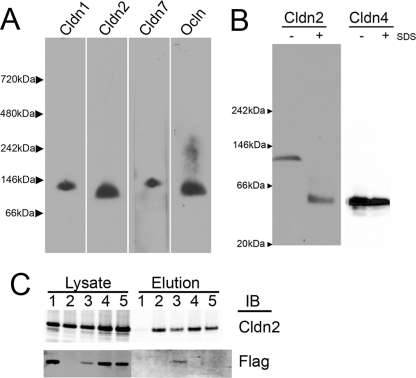FIGURE 1.
Claudins 1, 2, and 7 form discrete oligomers in MDCK cells. A, sucrose gradient-enriched plasma membrane fractions from MDCK II cells were extracted with 1% DDM, electrophoresed in BN-PAGE, transferred to PVDF membrane, and immunoblotted for cldn1, -2, and -7 and occludin (ocln); molecular weights determined by comparison with native mark molecular weight markers (Invitrogen) reveal that claudins but not occludin migrate consistent with being either dimers or trimers. B, stably transfected MDCK II cells were induced to express cldn2 or cldn4, extracted with 1% DDM without (−) or with (+) the addition of 1% SDS, and electrophoresed in BN-PAGE. SDS-treated samples reveal position of monomer; DDM-extracted cldn2 but not cldn4 migrates as a dimer. C, HEK cells were transfected with FLAG-cldn 2 (lane 1), His-cldn2 (lane 2), co-transfected with both His- and FLAG-cldn2 (lane 3), separately transfected with His- and FLAG-cldn2, and then co-plated (lane 4); all cells were extracted with 1% DDM, and supernatants from separately transfected cells were mixed after extraction (lane 5). Aliquots of DDM extracts were electrophoresed in SDS-PAGE and immunoblotted (IB) for cldn2 (upper left) and FLAG epitope (lower left). Remaining lysates were applied to Talon resin, washed, and eluted with imidazole; eluates were subjected to SDS-PAGE and immunoblotted with cldn2 (upper right) and FLAG antibodies (lower right). FLAG-cldn2 is retained on Talon resin when co-transfected with His-cldn2, consistent with homodimer formation during biosynthesis or trafficking but not via intercellular interactions.

